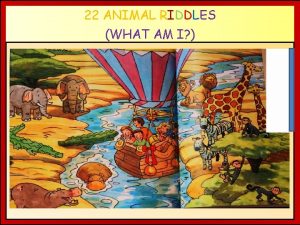Hexapod Concept Design Features Rear legs have underactuated






- Slides: 6

Hexapod Concept Design Features: • Rear legs have underactuated 4 -bar that operates in the vertical plane • Front and middle legs have wing, fore-aft DOF • Front legs also have a left-right DOF

Rear legs: very under-actuated • Each leg can have its own motor, or both can share a single motor and actuate out of phase Trajectory reverses itself to disengage spines motor • Rear legs are close enough together that they can accommodate most curved surfaces • Trajectory return path is very close to the ground (such as in cockroach hind limbs) • Discontinuity in trajectory at the foot can be customized to facilitate spine/foot disengagement Trajectory crank • Motor(s) can rotate continuously in one direction

Under-actuation Pros Cons • Fewer motors and batteries • Locked into alternating gaits • Less weight • Trajectory (and therefore single-leg forces) are fixed • Less volume for given body area = COM closer to wall • Turning could be hindered

Front legs have a Left-right squeeze DOF • Permits creating internal body forces force control • Allows front legs to search for a foothold • Should have one actuator control this DOF for both legs • Could have a 4 -bar or other linkage (instead of a pivot as shown) so that the front legs maintain their orientation • Can also (or instead) make the middle legs have this Left-right squeeze DOF • Having this DOF accomodates kinematic constraints

Multi-segment concept • Many segments with 1 DOF/leg—can have as many segments as you want! • Can have one very weak, slow wing DOF per body segment to change pose • Flexible spine like Sangbae’s quadruped concept —one actuator controls leftright turning for entire body, one controls vertical bending Legs pull inwards Side View Foot trajectory—allows spine engagement and disengagement

Foot engage/disengage actuator simple leg design? • If we have a foot engage/disengage actuator (e. g. Aaron’s slides), can we get away with a very under-actuated leg design? Foot engages Foot disengages











